April 20, 2022

Plantar fasciitis is an extremely serious disease. Plantar fasciitis is a common condition that affects about one per 10 individuals. It can be caused by any activity, from being sedentary to competitive.
The positive side is that a variety of home remedies can decrease or eliminate plantar fasciitis discomfort. Compression socks are an ideal option for certain people.
The compression socks in our list are broken down by category, but most are multipurpose and, with the exception of a specific indication, can be worn all day and during sports activity.
What is the best way to choose?
The first thing you should be thinking about when picking the right sleeves or socks for you is the amount of pressure you want to apply against your heel. These socks come in one of four compression levels. Here are some questions you can ask and the measurements you should look for when choosing the right best plantar fasciitis socks.
What amount of compression will you need?
For people suffering from conditions such as deep vein thrombosis or ulcers in the venous veins, it's best to use socks that are firmer than socks that are more firm.
A few reports suggest that many patients suffering from plantar fasciitis have significant relief from moderate or mild buy best compression socks online. You may need to try different types to find the one that's right for you.
How big do you require?
It is important to pay careful attention to the size of your sleeves to prevent plantar fasciitis and best plantar fasciitis socks.
Too tight socks could cause more harm than normal socks. Socks that are too loose will not provide any benefits.
Do the socks fit comfortably in your shoes?
You should also be aware of the strength of the stitching as well as the thickness of your socks.
What are the care guidelines for socks?
Some socks need to be washed by hand. Do not buy socks unless you're sure that you will clean them with a wash. They're not going to last as long if they're not properly cared for.
What is plantar fasciitis?
It is likely that you didn't think about your plantar fascia until the pain in your heel struck you. The plantar fascia the ligament connecting your heel to your front foot. It can be an issue for a lot of people. Over half of Americans suffer from heel pain. The most common cause is called plantar faciitis. The plantar fascia may be damaged or torn due to repetitive movements from exercise, running as well as weight growth. This can result in pain and inflammation.
Plantar fasciitis, also common in runners, is more common in pregnant women. The additional stress on ligaments can cause inflammation and pain. Don't let heel pain stop you from exercising. You can ease your heel pain by following these easy steps.
Solutions for stretching
Your feet's muscles are weak. or calves cause plantar fasciitis to worsen. Simple stretches can relieve or alleviate discomfort. Experts suffered from plantar faciitis due to excessive training and too many sprints. Expert stays heel pain at bay performing a stretching routine she practices and recommends for her clients.
Extent your calf bones
Standing at arm's reach from the wall.
Place your right foot behind your left.
Slowly and gently bend your left leg inwards.
Keep your right leg straight and your left foot on the ground.
Hold the stretch for 15 to 30 seconds before releasing. Repeat the stretch three times.
Reverse the position of your legs and repeat.
The stretch targets the gastrocnemius muscles located in your calf. You can increase the stretch by bending your legs a bit. Done this way it loosens the soleus muscle of the lower calf.
Extend your plantar fascia by sitting in the chair
The three stretching exercises for seated can also help alleviate plantar fasciitis. Be sure to sit straight when you perform them:
When you are sitting, put one foot on a foam roller an ice-cold container or a the frozen bottle of water. For one minute, do this and then switch to the other foot.
Next you'll need to cross one leg across one leg to create a big toe stretch. Hold your big toe and bring it up towards you, and hold for about 15-30 seconds. Do this three times. Then reverse the process and repeat using the other foot.
For the third sitting exercise make a long-length fold of a towel to make an exercise strap. Sit down, and place the folded towel on the arch of each foot. Grab the ends of the towel with your hands, and slowly pull the tops of your feet toward you. Hold for 15 to 30 seconds, then repeat the process three times.
Posted by: Tori Ramos at
09:02 AM
| No Comments
| Add Comment
Post contains 802 words, total size 6 kb.
35 queries taking 0.0718 seconds, 71 records returned.
Powered by Minx 1.1.6c-pink.









